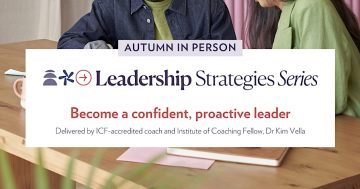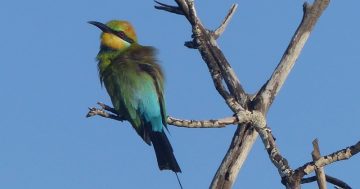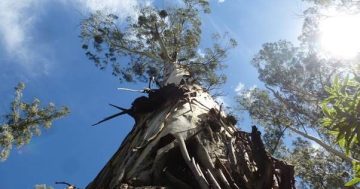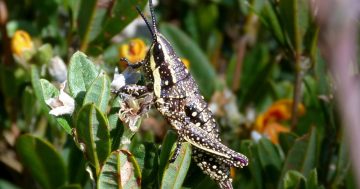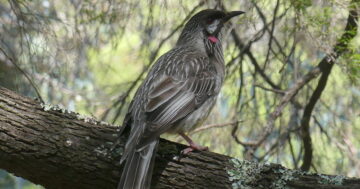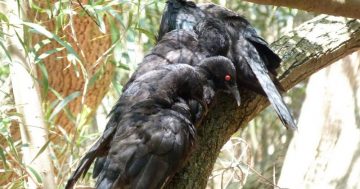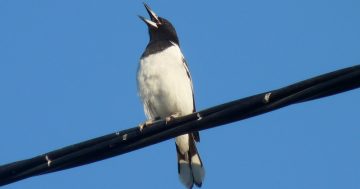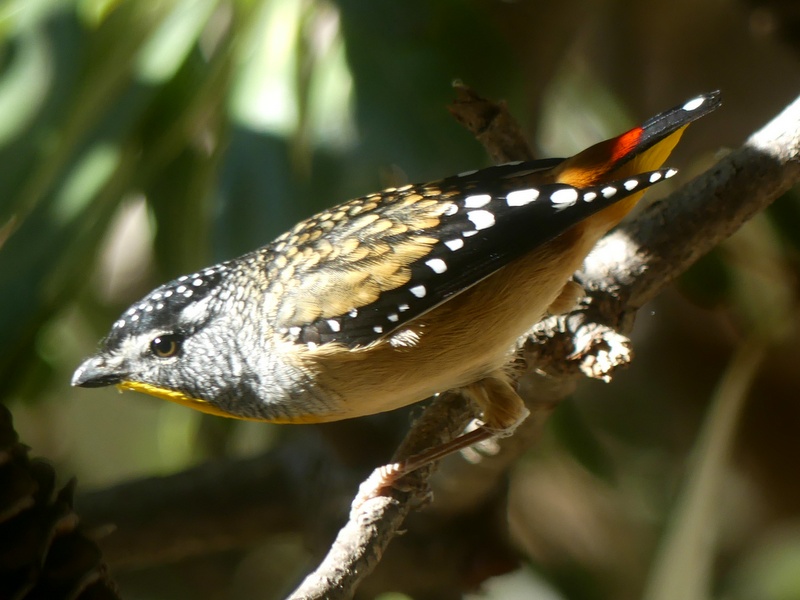
A handsome male Spotted Pardalote. Photos: Ian Fraser.
Some of Canberra’s most common birds are heard much more often than they are seen. Our two species of pardalotes are tiny – among Australia’s smallest birds, 10 cm long and weighing only 10 grams – and tend to lurk inconspicuously in tree canopies.
Their ringing voices, however, are out of all proportion to their size. It’s not recorded who first decided that Spotted Pardalotes say a silvery ‘Miss Piggy’ (with a slow ‘miss’ and quick ‘piggy’), but that’s what many of us hear.
It’s been reported that in the lead-up to the 1993 federal election Spotted Pardalotes in Canberra switched to saying ‘Paul Keating’ but that’s hard to verify. Striated Pardalotes utter a less contentious but very musical ‘whitticher’.

Striated Pardalote – his head is streaked rather than spotted.
The name ‘pardalote’ is a classical allusion to the brilliant spots of the first one named – think of ‘leopard’. Hence ‘Spotted Pardalote’ is repetitive and ‘Striated Pardalote’ is a contradiction, since ‘striated’ means ‘streaked’!
However, throughout the 19th century most people referred to them as a Diamond Bird (or similar), also from the spots, and it seems surprising that this name eventually largely disappeared.
It is impressive that such a tiny bird as the Spotted Pardalote is a very accomplished burrower, digging out a tunnel some 50 cm long with a nest chamber at the end.
They begin by pecking out a hole, then continue digging with their claws; those tiny feet can hurl excavated soil up to a metre away. Many a Canberra gardener has had to pause activities while the nest dug into the compost heap or pile of soil or sand has been completed and the chicks fledged.
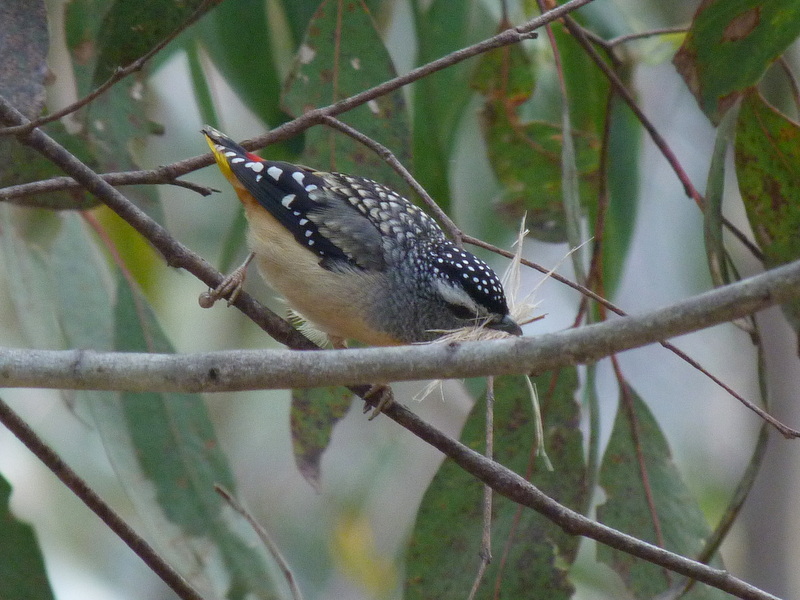
Spotted Pardalote carrying nesting material to line the chamber at the end of the burrow.
Some people put large wire mesh over the hole to allow the bird to come and go safely without being ambushed by cats.
Curiously, while Striated Pardalotes elsewhere also dig nesting burrows, in Canberra they almost never do, but use tree hollows. However, both species will also nest in roof cavities if they can access them.
Pardalotes feed among the foliage, often in large flocks, hanging from twigs and hovering at leaves to pick off small beetles, spiders, tree crickets and ants.
Their specialty is picking off lerps from eucalypt leaf surfaces with their stubby little bills. Lerps are the artefacts of sap-sucking insects (true bugs) which live by extracting liquid from eucalypt leaves.
They are after the precious nitrogen, but in the process they take in huge amounts of sugar in the sap, far more than they need, so they excrete it and use it to build a protective shelter – a lerp.
A pardalote’s bill is shaped to prise off the lerp, then snap up the little insect treat within it. On a warm summer day in the dry forests and woodlands around Canberra you can hear the pattering of a rain of lerp covers landing on the ground as the pardalote flocks feed.
Untold thousands of lerps are removed from eucalypts in this way and it is very likely that the trees, especially in drought times, would be far more stressed than they are without the ministrations of the browsing pardalotes.
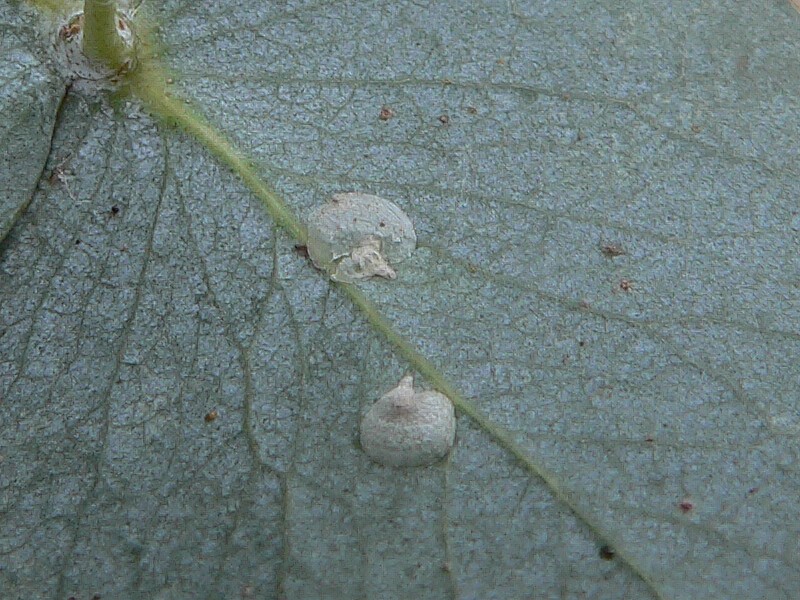
Lerps on the surface of a eucalypt leaf; the insect beneath each one is staple pardalote food.
At the other end of the pardalote from the stubby bill is a similarly stubby little tail, so that a flying pardalote looks like a big ladybird flitting between trees. For some reason the relatively huge wattlebirds hound them mercilessly, chasing them across big distances between trees, though any competition the pardalotes might offer them must be minute.
Some pardalote flocks come down from the ranges into Canberra for winter, while others fly north and return in spring. Many others seem to stay down in Canberra all year round, but it’s a complicated story that we don’t really understand.
Keep your eyes open for the pardalotes that are all around you. Recently I was attracted by the sound of tapping on the window and saw a male Spotted Pardalote searching for insects and small spiders, oblivious to me watching from the other side of the glass.
Watch the trees for tell-tale movements among the leaves. And always keep your ears open for Miss Piggy. Or Paul Keating.
Ian Fraser is a Canberra naturalist, conservationist and author. He has written on all aspects of natural history, advised the ACT Government on biodiversity and published multiple guides to the region’s flora and fauna.











